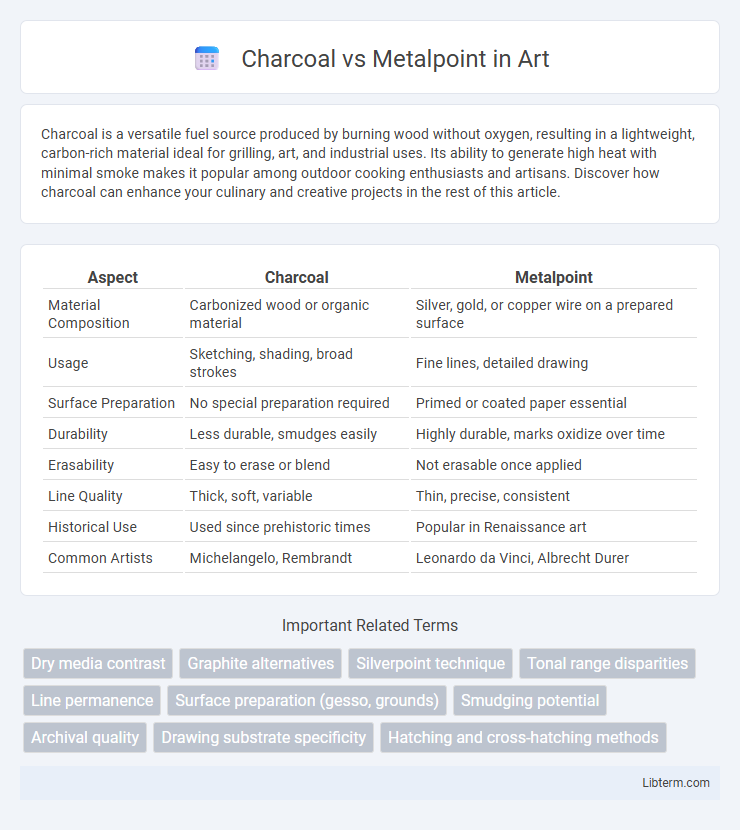Charcoal is a versatile fuel source produced by burning wood without oxygen, resulting in a lightweight, carbon-rich material ideal for grilling, art, and industrial uses. Its ability to generate high heat with minimal smoke makes it popular among outdoor cooking enthusiasts and artisans. Discover how charcoal can enhance your culinary and creative projects in the rest of this article.
Table of Comparison
| Aspect | Charcoal | Metalpoint |
|---|---|---|
| Material Composition | Carbonized wood or organic material | Silver, gold, or copper wire on a prepared surface |
| Usage | Sketching, shading, broad strokes | Fine lines, detailed drawing |
| Surface Preparation | No special preparation required | Primed or coated paper essential |
| Durability | Less durable, smudges easily | Highly durable, marks oxidize over time |
| Erasability | Easy to erase or blend | Not erasable once applied |
| Line Quality | Thick, soft, variable | Thin, precise, consistent |
| Historical Use | Used since prehistoric times | Popular in Renaissance art |
| Common Artists | Michelangelo, Rembrandt | Leonardo da Vinci, Albrecht Durer |
Introduction to Charcoal and Metalpoint
Charcoal, made from charred wood or organic materials, offers rich, deep blacks and a versatile medium for shading and expressive drawing techniques. Metalpoint utilizes a fine metal stylus, such as silver or copper, to produce precise, delicate lines on specially prepared surfaces, often valued for its permanence and historical significance in fine art. Both mediums provide unique textures and artistic effects, making them essential tools for artists exploring traditional drawing methods.
Historical Background of Drawing Media
Charcoal drawing dates back to prehistoric cave art, where early humans used burnt wood to create expressive, textured images on stone surfaces, making it one of the oldest known drawing media. Metalpoint, emerging during the medieval period and gaining prominence in the Renaissance, utilized thin metal rods--often silver, lead, or gold--on specially prepared paper to produce delicate, precise lines favored by artists like Leonardo da Vinci. The historical development of these media reflects shifts in artistic techniques and materials, with charcoal offering bold, dynamic strokes and metalpoint emphasizing detailed, controlled mark-making.
Material Composition and Tools Required
Charcoal consists of burned organic materials like wood, producing a soft, easily smudged medium ideal for sketching, while metalpoint involves using a thin metal wire--typically silver, gold, or copper--set in a pencil-like holder that leaves fine, delicate lines on specially prepared paper or ground. Creating charcoal drawings requires sticks, compressed charcoal, or charcoal pencils, along with fixatives to preserve the artwork, whereas metalpoint demands a prepared surface coated with a ground containing substances like bone ash, chalk, or gesso to enable metal marks to adhere properly. The distinct material composition and toolsets of charcoal and metalpoint define their unique textural qualities and artistic applications.
Surface Requirements for Each Medium
Charcoal requires a textured, toothy surface such as rough paper or untreated canvas to hold the particles effectively and create rich, dark tones. Metalpoint demands a specially prepared ground, often a coated or primed surface with a slightly abrasive quality, like gesso or bone ash, to ensure the metal leaves visible, consistent lines. Both mediums rely on surface texture, but charcoal thrives on porous, absorbent substrates, whereas metalpoint needs a smooth, yet gritty ground for optimal adherence.
Techniques and Drawing Methods
Charcoal offers artists a versatile medium for expressive shading and broad tonal ranges, achieved through smudging and blending techniques that enhance depth and texture. Metalpoint, historically using silver or other metals on specially prepared grounds, requires precise, delicate strokes producing fine, detailed lines that oxidize over time, creating a unique patina effect. While charcoal allows for rapid, forgiving sketching ideal for dynamic compositions, metalpoint demands controlled, deliberate mark-making suited for meticulous and refined drawings.
Visual Effects and Textures
Charcoal produces rich, velvety blacks with soft gradients and a matte finish that emphasizes depth and shadow, making it ideal for expressive, textured sketches. Metalpoint offers fine, delicate lines with a luminous, metallic sheen that gradually oxidizes to warm tones, creating subtle, precise details and a smooth surface texture. The contrast between charcoal's bold, tactile marks and metalpoint's refined, shimmering strokes defines their unique visual effects and artistic applications.
Archival Qualities and Longevity
Charcoal offers rich, deep tones but is prone to smudging and fading, making its archival qualities less reliable compared to metalpoint. Metalpoint, typically using silver or other metals on prepared surfaces, produces fine, permanent lines that resist deterioration over centuries. The longevity of metalpoint drawings surpasses charcoal artworks, preserving detail and clarity in museum collections and historic archives.
Challenges and Limitations
Charcoal presents challenges such as smudging and fragility, requiring fixatives to preserve artworks, while metalpoint demands a prepared surface and lacks erasure options, limiting flexibility. The permanence of metalpoint lines contrasts with charcoal's ease of manipulation, but metalpoint's reliance on specific metals like silver can lead to oxidation and fading over time. Both mediums challenge artists with technical constraints, influencing the choice between expressive versatility and enduring precision.
Artistic Styles Suited to Each Medium
Charcoal excels in expressive, bold, and gestural artistic styles due to its rich, deep blacks and ease of blending, making it ideal for dramatic portraits and dynamic figure studies. Metalpoint, favored during the Renaissance, suits precise, delicate line work essential for detailed drawings and intricate studies of form and texture. Artists often choose charcoal for its versatility and softness, while metalpoint is preferred for controlled, fine delineation in classical and architectural renderings.
Choosing Between Charcoal and Metalpoint
Choosing between charcoal and metalpoint depends on the desired artistic effect and technique; charcoal offers rich, deep blacks and easy blending, ideal for expressive shading and sketching. Metalpoint provides fine, precise lines with a subtle shimmer, suited for detailed, delicate work and permanent marks on prepared surfaces. Artists should consider durability, texture, and the nature of their project when selecting either medium for optimal results.
Charcoal Infographic

 libterm.com
libterm.com